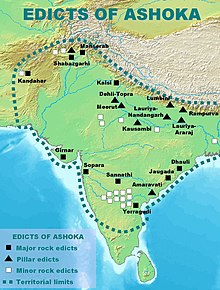History[edit]

Holy relic sites map of Andhra Pradesh
The stupa[edit]
The region between
Krishna and
Godavari rivers was an important place for
Buddhism from the 2nd century
BCE with Amaravati being one of them.
Buddhist stupa was built during the reign of
Ashoka in 200 CE, was carved with panels that tells the story of
Buddha. The discovery, misuse and destruction of the sculptures, preservation, distribution to various museums (Chennai, Calcutta, London, Masulipatnam etc.) have been poignantly described by Shimada.
[8] During the period of the decline of
Buddhism, this stupa was also neglected and it was buried under rubble. There is a 14th-century inscription in
Sri Lanka which mentions repairs made to the stupa and after that it was forgotten. The stupa is related to the
Vajrayanateachings of
Kalachakra, still practiced today in
Tibetan Buddhism.
[9] Dalai Lama of
Tibet conducted a Kalachakra initiation at this location in 2006.

Distribution of the Edicts of Ashoka
[10]
Ancient art[edit]
Art historians regard the Amaravati art as one of the three major styles or schools of ancient Indian art, the other two being the
Gandhara style and the
Mathura style. Some of the Buddhist sculptures of Amaravati betray a Greco-Roman influence that was the direct result of the close trade and diplomatic contacts between
South Indiaand the ancient
Romans. Indeed, Amaravati has itself yielded a few Roman coins. The
Government Museum at Egmore (Madras Museum) and
British Museum, London host the "
Amaravati Gallery".
[11]
Amaravati School[edit]
In Amaravati, situated in the eastern Deccan, a different type of art form evolved and flourished for nearly six centuries commencing from 200-100 BC. Patronized first by the
Satavahanas and later by the Ikshvakus and also by other groups (feudatories, officials, and merchants), four periods of activity are easily discernible.
[13]
The Amaravati school of art occupies a pre-eminent position in the history of Indian Art. With its beginning in 3rd century BC the Amaravati unfolds its chapters through the galaxy of sculptural wealth that once adorned the Mahachaitya the majestic monument of the Buddhists situated here with its history extending over a period of a millennium and a half.
[14]
Geography[edit]
Demographics[edit]
As of 2011
Census of India, the town had a population of 13,400. The total population constitute, 6,432 males and 6,968 females —a sex ratio of 1083 females per 1000 males. 1,321 children are in the age group of 0–6 years, of which 647 are boys and 674 are girls —a ratio of 1042 per 1000. The average literacy rate stands at 71.34% with 8,617 literates, significantly higher than the state average of 67.41%.
[4][16]
Tourist places[edit]

Front view of Amareswara temple Gopuram
The Amareswara (Siva) temple walls have lot of inscriptions that give information about the kings who ruled over the area. The present holy shrine of Amaralingeswara (Lord
Siva) temple is associated with the reign of
Vasireddy Venkatadri Nayudu who ruled the region before the advent of the British rule (See
Amararama). He was well known for his benevolence, munificence and construction of a large number of temples and education centers in the
Krishna river delta.
[17]
Transport[edit]
Culture[edit]
The town is a center of pilgrimage to both Hindus and Buddhists. Amaravati is also famous for the temple dedicated to the god
Siva. The main Hindu festivals celebrated are Mahasivaratri and the
Navaratri. The 30th
Kalachakra festival, a popular Buddhist ritual was held at Amaravati in the first week of January 2006









